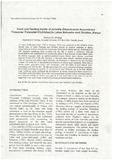Food and Feeding Habits of Juvenile Oreochromis leucostictus Trewavas (Teleostei=Cichlidae) in lake Naivasha and Oloidien, Kenya
Abstract
An eight month-study (July, 1990 to February, 1991) was conducted at five different littoral habitat types of Lakes Naivasha and Oloidien, Kenya, to examine variations in dietary composition of juvenile Oreochromis leucostictus Trewavas by habitat and size. Examination of 583 stomachs containing food, revealed that the fish is mainly a detritivore, although phytoplankton and zooplankton were occasionally taken in large amounts at some habitat types. In densely vegetated, fully or partially-enclosed lagoon habitat types, detritus constituted between 58 and 67% of the diet. However, in the more open, densely vegetated habitat types with soft substrata and slightly higher alkalinity, the importance of detritus to the diet decreased to about 32% while that of phytoplankton increased to an almost equal proportion. More food of animal origin, particularly insects and crustaceans, were also taken at such habitat types, constituting over 30% the diet. The blue-green alga, Microsystis aeruginosa Kutzing constituted the primary food item for juvenile 0. leucostictus at Lake Oloidien, due to the high alkaline water conditions which prohibited the development of diverse faunal and floral composition. Food habits of the fish shifted from a diet consisting of large amounts of food of animal origin to one composed mainly of detritus and algae at a very small size of less than 2.5 cm SL, suggesting a very early change in physiological and gut morphological adaptations.
Collections
- Journal Articles (PAS) [303]

